Objectives Introduction Etiology of Infertility








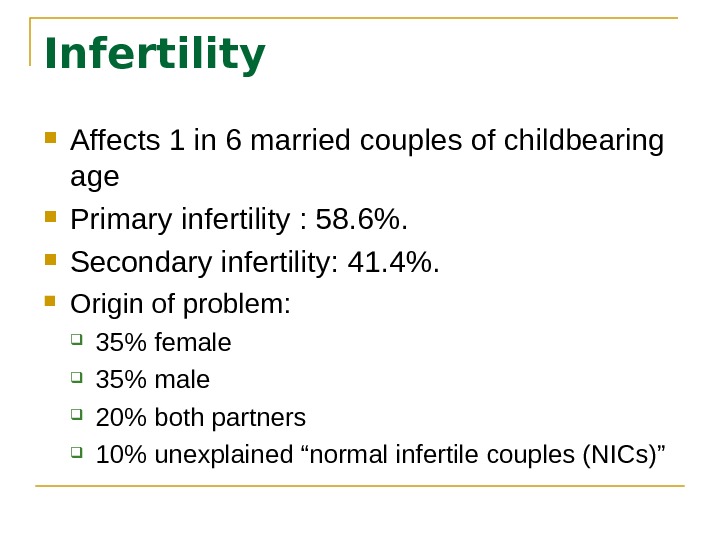













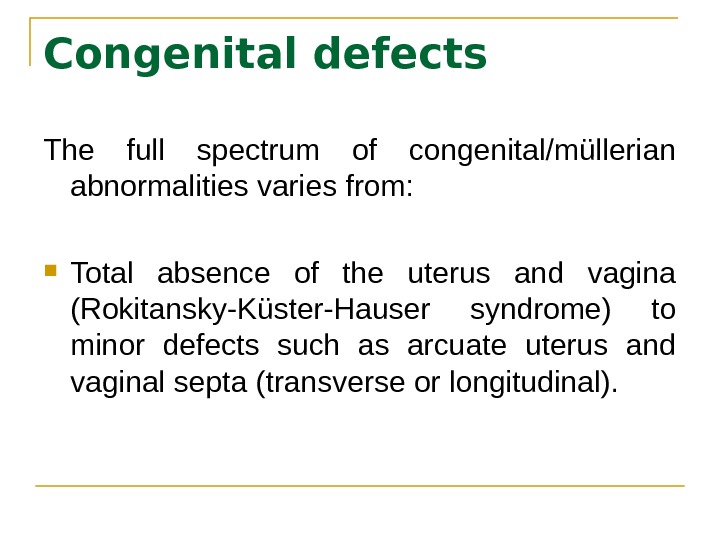
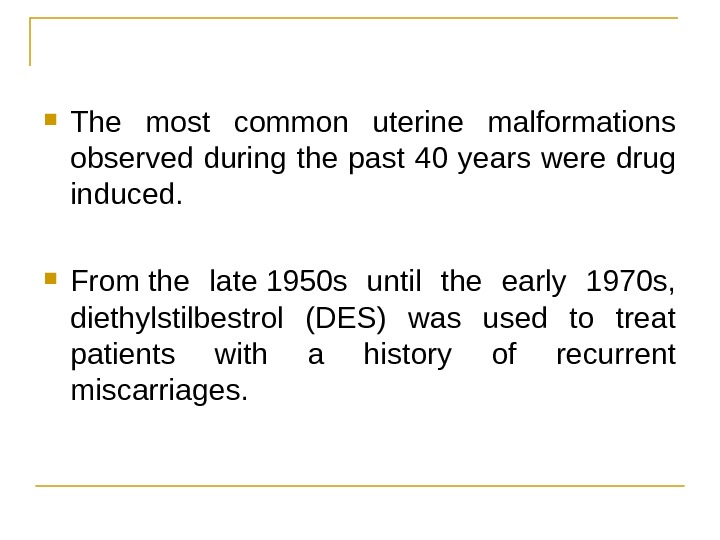





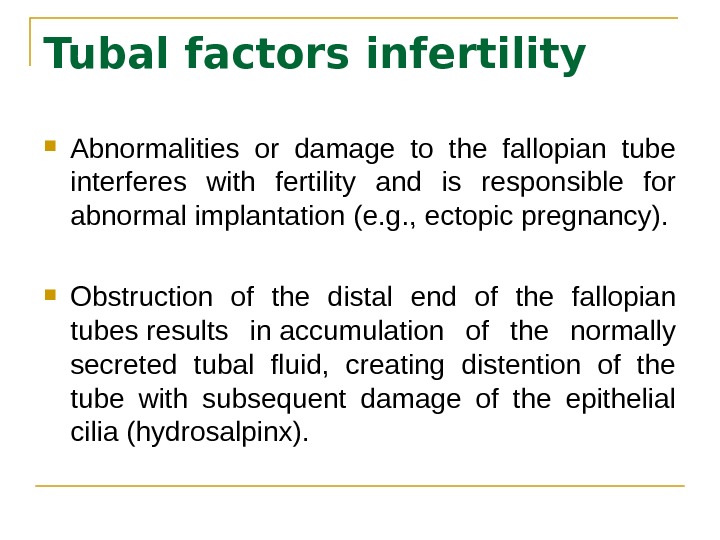
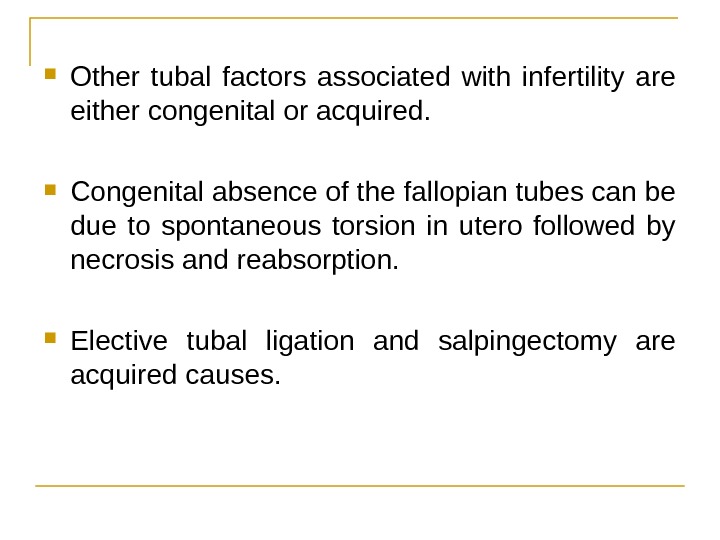















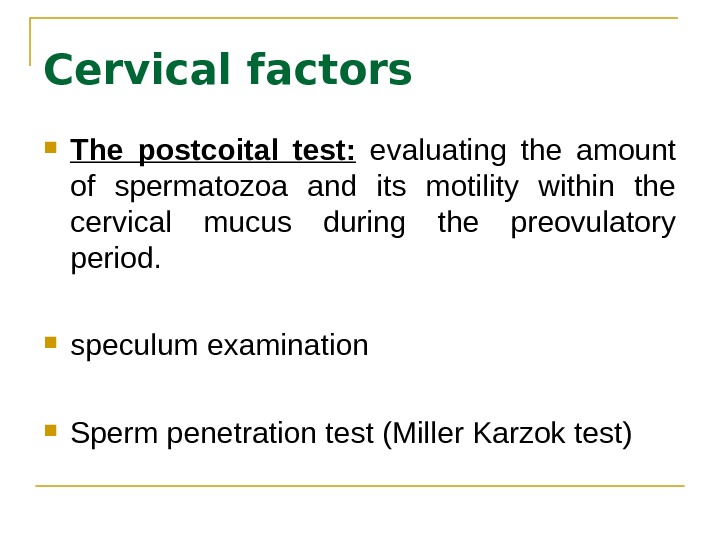


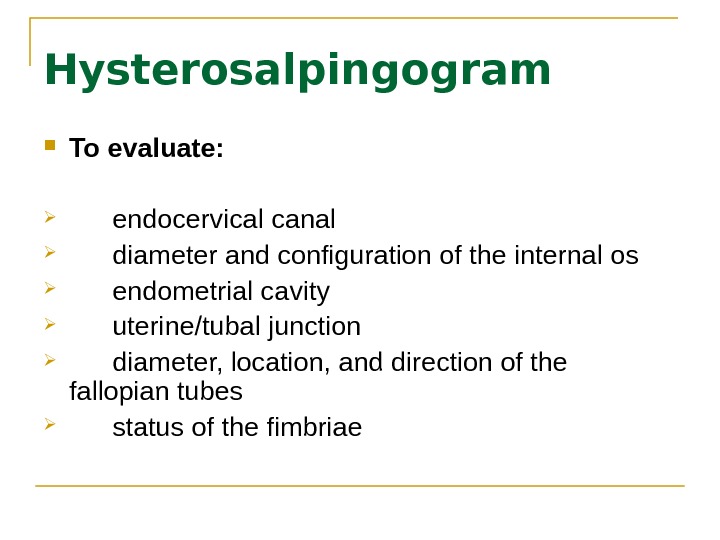

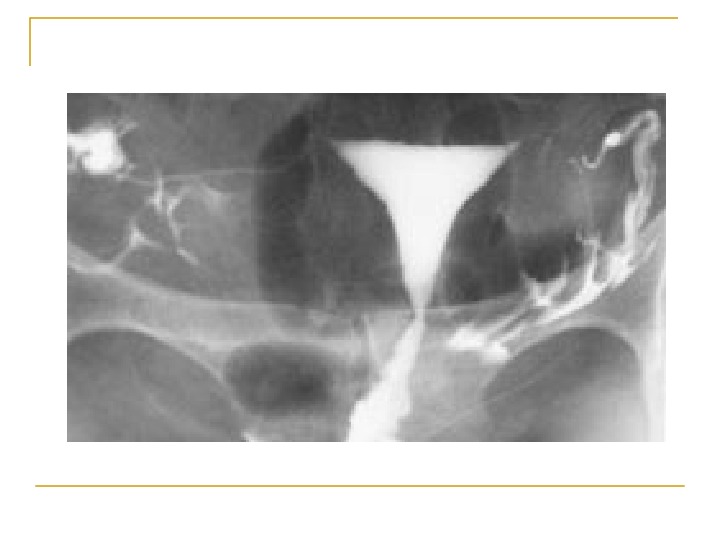






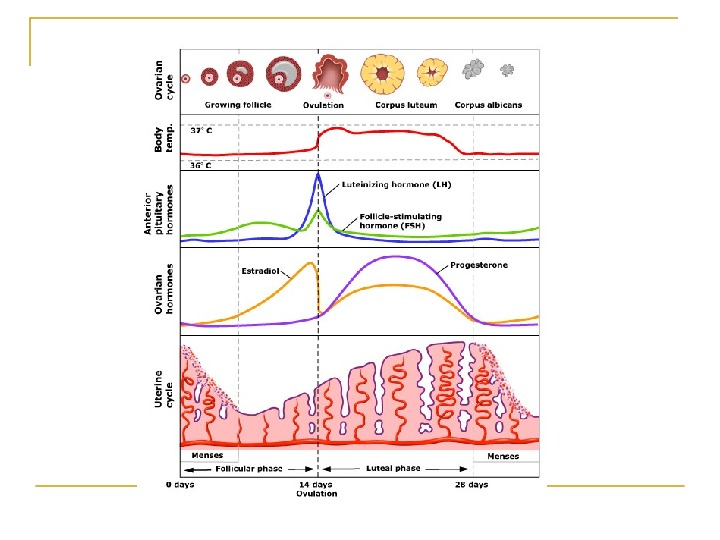





























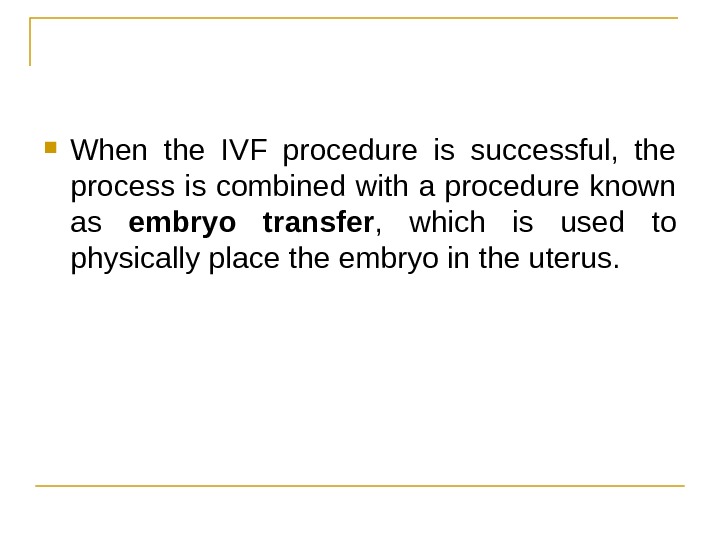




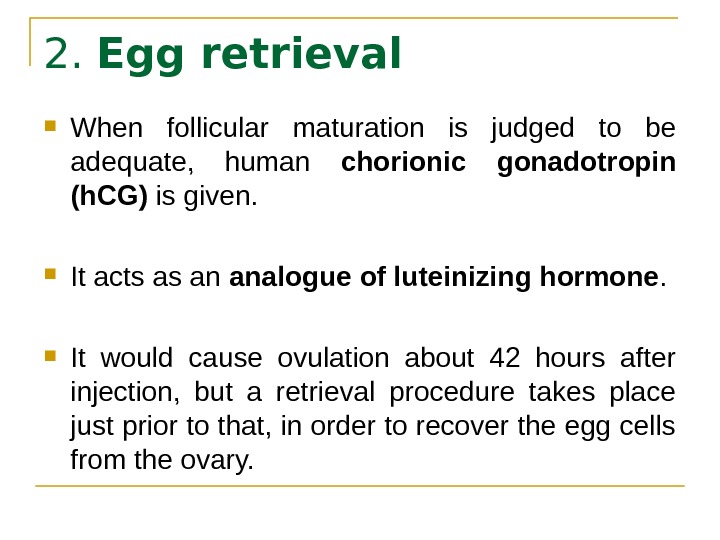













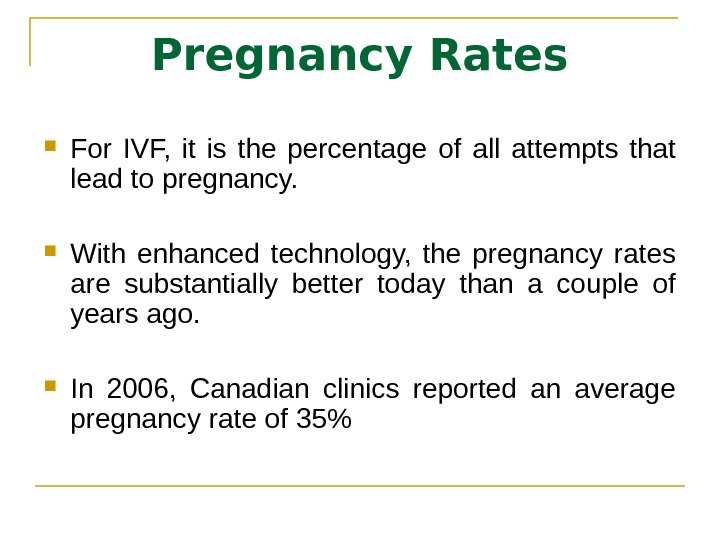







- Размер: 8.4 Mегабайта
- Количество слайдов: 114
Описание презентации Objectives Introduction Etiology of Infertility по слайдам
 Objectives Introduction Etiology of Infertility General Guidance On Evaluation Of Infertility Comprehensive Evaluation Of Infertility Treatment Assisted Reproductive Technologies Results
Objectives Introduction Etiology of Infertility General Guidance On Evaluation Of Infertility Comprehensive Evaluation Of Infertility Treatment Assisted Reproductive Technologies Results
 Introductio n
Introductio n

 Definitions & Terminology Fertility : the capacity to reproduce or the state of being fertile. Fecundability : the probability of achieving a pregnancy each month. Fecundity : the ability to achieve a live birth within 1 menstrual cycle.
Definitions & Terminology Fertility : the capacity to reproduce or the state of being fertile. Fecundability : the probability of achieving a pregnancy each month. Fecundity : the ability to achieve a live birth within 1 menstrual cycle.
 Definitions & Terminology Infertility : one year of unprotected coitus without conception. Primary infertility : couple who has never achieved a pregnancy. Secondary infertility : implies that at least one previous conception has taken place.
Definitions & Terminology Infertility : one year of unprotected coitus without conception. Primary infertility : couple who has never achieved a pregnancy. Secondary infertility : implies that at least one previous conception has taken place.
 Epidemiology Fecundability rate in the general reproductive-aged population is fairly constant and is approximately 0. 22 per month. Fecundity rate is estimated to be 0. 15 -0. 18 per month.
Epidemiology Fecundability rate in the general reproductive-aged population is fairly constant and is approximately 0. 22 per month. Fecundity rate is estimated to be 0. 15 -0. 18 per month.
 Fecundability 20 -25% of couples will conceive/cycle. 50% should conceive after 3 -4 months. 95% should conceive after 1 year.
Fecundability 20 -25% of couples will conceive/cycle. 50% should conceive after 3 -4 months. 95% should conceive after 1 year.
 Infertility Affects 1 in 6 married couples of childbearing age Primary infertility : 58. 6%. Secondary infertility: 41. 4%. Origin of problem: 35% female 35% male 20% both partners 10% unexplained “normal infertile couples (NICs)”
Infertility Affects 1 in 6 married couples of childbearing age Primary infertility : 58. 6%. Secondary infertility: 41. 4%. Origin of problem: 35% female 35% male 20% both partners 10% unexplained “normal infertile couples (NICs)”
 Etiology of Infertility
Etiology of Infertility
 Requirements for Normal Reproduction 1) Release of a normal preovulatory oocyte. 2) Production of adequate spermatozoa. 3) Normal transport of the gametes to the ampullary portion of the fallopian tube (where fertilization occurs). 4) Subsequent transport of the cleaving embryo into the endometrial cavity for implantation and development.
Requirements for Normal Reproduction 1) Release of a normal preovulatory oocyte. 2) Production of adequate spermatozoa. 3) Normal transport of the gametes to the ampullary portion of the fallopian tube (where fertilization occurs). 4) Subsequent transport of the cleaving embryo into the endometrial cavity for implantation and development.
 Female Factor Infertility Female factor infertility can be divided into several categories: Cervical factor infertility Uterine factor infertility Ovarian factor infertility Tubal factors infertility and others
Female Factor Infertility Female factor infertility can be divided into several categories: Cervical factor infertility Uterine factor infertility Ovarian factor infertility Tubal factors infertility and others
 Cervical factor infertility Account for 5 -10% of infertility. Can be caused by: Cervical stenosis Abnormalities of the mucus-sperm interaction Antisperm antibodies
Cervical factor infertility Account for 5 -10% of infertility. Can be caused by: Cervical stenosis Abnormalities of the mucus-sperm interaction Antisperm antibodies
 Cervical mucus production and characteristics 1. It changes according to the estrogen concentration during the late follicular phase. 2. At the beginning of the menstrual Cycle: scanty, viscous, and very cellular forms a netlike structure that does not allow the passage of sperm.
Cervical mucus production and characteristics 1. It changes according to the estrogen concentration during the late follicular phase. 2. At the beginning of the menstrual Cycle: scanty, viscous, and very cellular forms a netlike structure that does not allow the passage of sperm.

 Cont, , , 3. Secretion ↑ in mid follicular phase and reaches its maximum 24 -48 h before ovulation. 4. Water and salt concentration increases, changing the physical characteristics of the mucus: thin, watery, alkaline, acellular, and elastic (spinnbarkheit) → ↑Na. Cl concentration 5. Fernlike pattern when the mucus is allowed to dry on a cover slide under the microscope
Cont, , , 3. Secretion ↑ in mid follicular phase and reaches its maximum 24 -48 h before ovulation. 4. Water and salt concentration increases, changing the physical characteristics of the mucus: thin, watery, alkaline, acellular, and elastic (spinnbarkheit) → ↑Na. Cl concentration 5. Fernlike pattern when the mucus is allowed to dry on a cover slide under the microscope

 Cont, , , The mucus organizes itself, forming multiple microchannels so the spermatozoa can travel through. Spermatozoa simultaneously undergo activation and capacitation. The mucus acts as a filter for abnormal spermatozoa and cellular debris present in the semen.
Cont, , , The mucus organizes itself, forming multiple microchannels so the spermatozoa can travel through. Spermatozoa simultaneously undergo activation and capacitation. The mucus acts as a filter for abnormal spermatozoa and cellular debris present in the semen.
 Cont, , , Mucus secretion may be altered by hormonal changes and medications, especially drugs like clomiphene citrate , which decrease the production. Hypoestrogenism may cause thickened cervical mucus, which impairs the passage of sperm.
Cont, , , Mucus secretion may be altered by hormonal changes and medications, especially drugs like clomiphene citrate , which decrease the production. Hypoestrogenism may cause thickened cervical mucus, which impairs the passage of sperm.
 Cont, , , Cervical stenosis can cause infertility by blocking the passage of sperm from the cervix to the intrauterine cavity. Cervical stenosis can be congenital or acquired in etiology, resulting from surgical procedures, infections, hypoestrogenism, and radiation therapy.
Cont, , , Cervical stenosis can cause infertility by blocking the passage of sperm from the cervix to the intrauterine cavity. Cervical stenosis can be congenital or acquired in etiology, resulting from surgical procedures, infections, hypoestrogenism, and radiation therapy.

 Uterine factor infertility May be associated with primary infertility or with pregnancy wastage and premature delivery. Uterine factors can be congenital or acquired. They may affect the endometrium or myometrium and are responsible for 2 -5% of infertility cases.
Uterine factor infertility May be associated with primary infertility or with pregnancy wastage and premature delivery. Uterine factors can be congenital or acquired. They may affect the endometrium or myometrium and are responsible for 2 -5% of infertility cases.
 Congenital defects The full spectrum of congenital/müllerian abnormalities varies from: Total absence of the uterus and vagina (Rokitansky-Küster-Hauser syndrome) to minor defects such as arcuate uterus and vaginal septa (transverse or longitudinal).
Congenital defects The full spectrum of congenital/müllerian abnormalities varies from: Total absence of the uterus and vagina (Rokitansky-Küster-Hauser syndrome) to minor defects such as arcuate uterus and vaginal septa (transverse or longitudinal).
 The most common uterine malformations observed during the past 40 years were drug induced. From the late 1950 s until the early 1970 s, diethylstilbestrol (DES) was used to treat patients with a history of recurrent miscarriages.
The most common uterine malformations observed during the past 40 years were drug induced. From the late 1950 s until the early 1970 s, diethylstilbestrol (DES) was used to treat patients with a history of recurrent miscarriages.
 Ddiethylstilbestrol (DES( DES was found to be responsible for inducing malformations of the uterine cervix, irregularities of the endometrial cavity (eg, T-shaped uterus), malfunction of the fallopian tubes, menstrual irregularities, and the development of clear cell carcinoma of the vagina.
Ddiethylstilbestrol (DES( DES was found to be responsible for inducing malformations of the uterine cervix, irregularities of the endometrial cavity (eg, T-shaped uterus), malfunction of the fallopian tubes, menstrual irregularities, and the development of clear cell carcinoma of the vagina.
 Premature delivery has been associated with cervical incompetence. Unicornuate uterus associated with a blind horn, and septate uterus. Septate uterus may also be responsible for implantation problems and first-trimester miscarriages.
Premature delivery has been associated with cervical incompetence. Unicornuate uterus associated with a blind horn, and septate uterus. Septate uterus may also be responsible for implantation problems and first-trimester miscarriages.
 Acquired defects Endometritis associated with a traumatic delivery, dilatation and curettage, intrauterine device, or any instrumentation of the endometrial cavity may create intrauterine adhesions or synechiae (ie, Asherman syndrome), with partial or total obliteration of the endometrial cavity.
Acquired defects Endometritis associated with a traumatic delivery, dilatation and curettage, intrauterine device, or any instrumentation of the endometrial cavity may create intrauterine adhesions or synechiae (ie, Asherman syndrome), with partial or total obliteration of the endometrial cavity.
 Cont, , , Placental polyps may develop from placental remains. Intrauterine and submucosal fibroids are very common, affecting 25 -50% of women. They may also be implicated in implantation failure, early miscarriages, premature delivery, and abruptio placentae.
Cont, , , Placental polyps may develop from placental remains. Intrauterine and submucosal fibroids are very common, affecting 25 -50% of women. They may also be implicated in implantation failure, early miscarriages, premature delivery, and abruptio placentae.
 Ovarian factor infertility Ovulatory dysfunction is defined as an alteration in the frequency and duration of the menstrual cycle. Failure to ovulate is the most common infertility problem. Absence of ovulation can be associated with primary amenorrhea, secondary amenorrhea, or oligomenorrhea.
Ovarian factor infertility Ovulatory dysfunction is defined as an alteration in the frequency and duration of the menstrual cycle. Failure to ovulate is the most common infertility problem. Absence of ovulation can be associated with primary amenorrhea, secondary amenorrhea, or oligomenorrhea.
 Tubal factors infertility Abnormalities or damage to the fallopian tube interferes with fertility and is responsible for abnormal implantation (e. g. , ectopic pregnancy). Obstruction of the distal end of the fallopian tubes results in accumulation of the normally secreted tubal fluid, creating distention of the tube with subsequent damage of the epithelial cilia (hydrosalpinx).
Tubal factors infertility Abnormalities or damage to the fallopian tube interferes with fertility and is responsible for abnormal implantation (e. g. , ectopic pregnancy). Obstruction of the distal end of the fallopian tubes results in accumulation of the normally secreted tubal fluid, creating distention of the tube with subsequent damage of the epithelial cilia (hydrosalpinx).
 Other tubal factors associated with infertility are either congenital or acquired. Congenital absence of the fallopian tubes can be due to spontaneous torsion in utero followed by necrosis and reabsorption. Elective tubal ligation and salpingectomy are acquired causes.
Other tubal factors associated with infertility are either congenital or acquired. Congenital absence of the fallopian tubes can be due to spontaneous torsion in utero followed by necrosis and reabsorption. Elective tubal ligation and salpingectomy are acquired causes.
 Advanced age The prevalence of infertility rises dramatically as age increases. Fertility decreases with marriage duration because of less frequent intercourse and/or the use of contraception.
Advanced age The prevalence of infertility rises dramatically as age increases. Fertility decreases with marriage duration because of less frequent intercourse and/or the use of contraception.
 Peritoneal Factor Infertility Pelvic inflammatory disease Associated with gonorrhea and chlamydia infection. The rate of damage to the fallopian tubes increases with subsequent PID episodes. Westrom reported a 21% incidence of infertility in a group of Swedish women who were diagnosed with PID, which was confirmed by laparoscopy findings.
Peritoneal Factor Infertility Pelvic inflammatory disease Associated with gonorrhea and chlamydia infection. The rate of damage to the fallopian tubes increases with subsequent PID episodes. Westrom reported a 21% incidence of infertility in a group of Swedish women who were diagnosed with PID, which was confirmed by laparoscopy findings.
 Endometriosis Remains an enigmatic disease that affects women during their reproductive years. The evolution of the disease is unpredictable. Pelvic pain and reproductive failure are the two major complaints of patients with endometriosis Severe endometriosis with damage to the fallopian tubes and ovaries due to adhesions or the presence of endometriomas is an obvious cause of infertility
Endometriosis Remains an enigmatic disease that affects women during their reproductive years. The evolution of the disease is unpredictable. Pelvic pain and reproductive failure are the two major complaints of patients with endometriosis Severe endometriosis with damage to the fallopian tubes and ovaries due to adhesions or the presence of endometriomas is an obvious cause of infertility

 Approach To Infertility and Evaluation of Infertile Couple
Approach To Infertility and Evaluation of Infertile Couple
 General Guidance on Evaluation of Infertility is a problem that involves both partners. The consultation is incomplete if only the woman is evaluated.
General Guidance on Evaluation of Infertility is a problem that involves both partners. The consultation is incomplete if only the woman is evaluated.
 History Type of infertility (primary or secondary) Detailed history of previous pregnancies Specific questions: Frequency of intercourse Use of lubricants
History Type of infertility (primary or secondary) Detailed history of previous pregnancies Specific questions: Frequency of intercourse Use of lubricants
 Female: menstrual history frequency patterns since menarche.
Female: menstrual history frequency patterns since menarche.
 Male: semen analysis results history of impotence premature ejaculation change in libido history of testicular trauma Infections
Male: semen analysis results history of impotence premature ejaculation change in libido history of testicular trauma Infections
 Ask the couple about: surgical contraception weight changes Lifestyle exercise medical treatment Smoking
Ask the couple about: surgical contraception weight changes Lifestyle exercise medical treatment Smoking
 Physical Body Mass Index skin evaluation of hair distribution Malformed face or limbs (congenital abnormalities) visual examination of the genitals and breasts
Physical Body Mass Index skin evaluation of hair distribution Malformed face or limbs (congenital abnormalities) visual examination of the genitals and breasts
 Comprehensive Evaluation of Infertility Cervical factors Uterine factors Tubal and peritoneal factors Ovarian factors
Comprehensive Evaluation of Infertility Cervical factors Uterine factors Tubal and peritoneal factors Ovarian factors

 Cervical factors Congenital : Severe stenosis Inflammatory : chronic cervicitis Neoplastic causes : Cervical polyp or cervical fibroid. Cervical displacement as in prolapse or retroversion. Increased viscosity of the cervical discharge.
Cervical factors Congenital : Severe stenosis Inflammatory : chronic cervicitis Neoplastic causes : Cervical polyp or cervical fibroid. Cervical displacement as in prolapse or retroversion. Increased viscosity of the cervical discharge.

 Cervical factors The postcoital test: evaluating the amount of spermatozoa and its motility within the cervical mucus during the preovulatory period. speculum examination Sperm penetration test (Miller Karzok test)
Cervical factors The postcoital test: evaluating the amount of spermatozoa and its motility within the cervical mucus during the preovulatory period. speculum examination Sperm penetration test (Miller Karzok test)
 Uterine factors Congenital causes: Uterine aplasia, hypoplasia, septate uterus. Inflammatory causes : Tuberculous endometritis. Neoplastic causes : Fibroid polyp.
Uterine factors Congenital causes: Uterine aplasia, hypoplasia, septate uterus. Inflammatory causes : Tuberculous endometritis. Neoplastic causes : Fibroid polyp.
 HSG pelvic ultrasonography Hysteroscopy MRI
HSG pelvic ultrasonography Hysteroscopy MRI
 Hysterosalpingogram To evaluate: endocervical canal diameter and configuration of the internal os endometrial cavity uterine/tubal junction diameter, location, and direction of the fallopian tubes status of the fimbriae
Hysterosalpingogram To evaluate: endocervical canal diameter and configuration of the internal os endometrial cavity uterine/tubal junction diameter, location, and direction of the fallopian tubes status of the fimbriae
 The HSG should be performed during the early follicular phase. At this time, the endometrium is thin and the HSG provides better delineation of minor defects. In addition, the possibility of accidental irradiation to the fetus in an undiagnosed pregnancy is eliminated.
The HSG should be performed during the early follicular phase. At this time, the endometrium is thin and the HSG provides better delineation of minor defects. In addition, the possibility of accidental irradiation to the fetus in an undiagnosed pregnancy is eliminated.

 T-shaped uterus
T-shaped uterus
 Endometrial biopsy
Endometrial biopsy
 Tubal and peritoneal factors Congenital: aplasia or hypoplasia of the fallopian tube. Traumatic causes: Tubal ligation or salpingectomy. Inflammatory causes: Salpingitis Neoplastic causes: broad ligamentary fibroids. Endometriosis: It causes pelvic and peritubal adhesions.
Tubal and peritoneal factors Congenital: aplasia or hypoplasia of the fallopian tube. Traumatic causes: Tubal ligation or salpingectomy. Inflammatory causes: Salpingitis Neoplastic causes: broad ligamentary fibroids. Endometriosis: It causes pelvic and peritubal adhesions.
 Laparoscopy hysterosalpingogram
Laparoscopy hysterosalpingogram

 Ovarian factors Menstrual history Basal body temperature Hormone levels Blood levels of the hormone progesterone are a more accurate indicator of ovulation.
Ovarian factors Menstrual history Basal body temperature Hormone levels Blood levels of the hormone progesterone are a more accurate indicator of ovulation.


 Evaluation of the Male Partner Semen analysis: The basic semen analysis assesses sperm concentration motility Morphology viability.
Evaluation of the Male Partner Semen analysis: The basic semen analysis assesses sperm concentration motility Morphology viability.
 Volume — 2 -5 m. L p. H level — 7. 2 -7. 8 Sperm concentration — 20 million or greater Motility — 50%, forward progression Morphology — Normal sperm (>4%) White blood cells — Fewer than 1 million cells/µL
Volume — 2 -5 m. L p. H level — 7. 2 -7. 8 Sperm concentration — 20 million or greater Motility — 50%, forward progression Morphology — Normal sperm (>4%) White blood cells — Fewer than 1 million cells/µL
 Interpretation of semen analysis Azoospermia indicates absence of sperm Oligozoospermia indicates a concentration of fewer than 20 million sperm/m. L Asthenozoospermia indicates sperm motility of less than 50%. Teratospermia Hypospermia semen volume less than 2 m. L per ejaculation. Hyperspermia semen volume more than 8 m. L per ejaculation.
Interpretation of semen analysis Azoospermia indicates absence of sperm Oligozoospermia indicates a concentration of fewer than 20 million sperm/m. L Asthenozoospermia indicates sperm motility of less than 50%. Teratospermia Hypospermia semen volume less than 2 m. L per ejaculation. Hyperspermia semen volume more than 8 m. L per ejaculation.
 Kruger criteria If the initial semen analysis is abnormal, the clinician will often request an additional sample , this is best done to two weeks later.
Kruger criteria If the initial semen analysis is abnormal, the clinician will often request an additional sample , this is best done to two weeks later.
 Teratospermia
Teratospermia
 Blood tests: to measure total testosterone, LH , FSH and prolactin may be ordered. Genetic tests: check for absent or abnormal regions of the male chromosomes (Y chromosome).
Blood tests: to measure total testosterone, LH , FSH and prolactin may be ordered. Genetic tests: check for absent or abnormal regions of the male chromosomes (Y chromosome).
 Other tests If a blockage in the reproductive tract is suspected, a transrectal ultrasound test may be ordered. If retrograde ejaculation is suspected, a post-ejaculation urine sample is needed. A testicular biopsy may be needed to examine the microscopic structure of the testes and determine if sperm are present.
Other tests If a blockage in the reproductive tract is suspected, a transrectal ultrasound test may be ordered. If retrograde ejaculation is suspected, a post-ejaculation urine sample is needed. A testicular biopsy may be needed to examine the microscopic structure of the testes and determine if sperm are present.
 Infertility Treatment
Infertility Treatment
 Treatment of infertility depends on the cause, diagnosis, duration of infertility, age of the partners and many personal preferences. Some causes of infertility cannot be corrected. A woman can still become pregnant with assisted reproductive technology or other procedures to restore fertility.
Treatment of infertility depends on the cause, diagnosis, duration of infertility, age of the partners and many personal preferences. Some causes of infertility cannot be corrected. A woman can still become pregnant with assisted reproductive technology or other procedures to restore fertility.
 Restoring fertility: These approaches can involve steps related to the male or to the female, or both. Increase frequency of intercourse: two to three times a week of intercourse may improve fertility. o Sperm survive in the female reproductive tract for up to 72 hours, and an egg can be fertilized for up to 24 hours after ovulation.
Restoring fertility: These approaches can involve steps related to the male or to the female, or both. Increase frequency of intercourse: two to three times a week of intercourse may improve fertility. o Sperm survive in the female reproductive tract for up to 72 hours, and an egg can be fertilized for up to 24 hours after ovulation.
 Treatment for men General sexual problems: Addressing impotence or premature ejaculation can improve fertility. Treatment for these problems often is with medication or behavioral approaches. Lack of sperm: surgery or hormones to correct the problem or use of assisted reproductive technology is sometimes possible. Varicocele can often be surgically corrected.
Treatment for men General sexual problems: Addressing impotence or premature ejaculation can improve fertility. Treatment for these problems often is with medication or behavioral approaches. Lack of sperm: surgery or hormones to correct the problem or use of assisted reproductive technology is sometimes possible. Varicocele can often be surgically corrected.
 Treatment for women Stimulating ovulation with fertility drugs: Fertility drugs are the main treatment for women who are infertile due to ovulation disorders. These medications regulate or induce ovulation, and work like natural hormones to trigger ovulation such as: Follicle-stimulating hormone (FSH) and Luteinizing hormone (LH).
Treatment for women Stimulating ovulation with fertility drugs: Fertility drugs are the main treatment for women who are infertile due to ovulation disorders. These medications regulate or induce ovulation, and work like natural hormones to trigger ovulation such as: Follicle-stimulating hormone (FSH) and Luteinizing hormone (LH).
 Commonly used fertility drugs include: Clomiphene citrate (Clomid, Serophene(: o Taken orally and stimulates ovulation in women who have PCOS or other ovulatory disorders. o It causes the pituitary gland to release more FSH and LH, which stimulate the growth of an ovarian follicle containing an egg.
Commonly used fertility drugs include: Clomiphene citrate (Clomid, Serophene(: o Taken orally and stimulates ovulation in women who have PCOS or other ovulatory disorders. o It causes the pituitary gland to release more FSH and LH, which stimulate the growth of an ovarian follicle containing an egg.
 Human menopausal gonadotropin, or h. MG (Repronex(: This is an injected medication is for women who do not ovulate on their own due to the failure of the pituitary gland to stimulate ovulation. Unlike clomiphene, which stimulates the pituitary gland, h. MG and other gonadotropins directly stimulate the ovaries. This drug contains both FSH and LH.
Human menopausal gonadotropin, or h. MG (Repronex(: This is an injected medication is for women who do not ovulate on their own due to the failure of the pituitary gland to stimulate ovulation. Unlike clomiphene, which stimulates the pituitary gland, h. MG and other gonadotropins directly stimulate the ovaries. This drug contains both FSH and LH.
 Follicle-stimulating hormone, or FSH (Gonal-F, Follistim, Bravelle(: o FSH works by stimulating the ovaries to mature egg follicles. Human chorionic gonadotropin, or HCG (Ovidrel, Pregnyl(: o Used in combination with clomiphene, h. MG and FSH, this drug stimulates the follicle to release its egg (ovulate).
Follicle-stimulating hormone, or FSH (Gonal-F, Follistim, Bravelle(: o FSH works by stimulating the ovaries to mature egg follicles. Human chorionic gonadotropin, or HCG (Ovidrel, Pregnyl(: o Used in combination with clomiphene, h. MG and FSH, this drug stimulates the follicle to release its egg (ovulate).
 Gonadotropin-releasing hormone (Gn-RH) analogs: This treatment is for women with irregular ovulatory cycles or who ovulate prematurely before the lead follicle is mature enough during h. MG treatment. Gn-RH analogs deliver constant Gn-RH to the pituitary gland, which alters hormone production, so that can induce follicle growth with FSH.
Gonadotropin-releasing hormone (Gn-RH) analogs: This treatment is for women with irregular ovulatory cycles or who ovulate prematurely before the lead follicle is mature enough during h. MG treatment. Gn-RH analogs deliver constant Gn-RH to the pituitary gland, which alters hormone production, so that can induce follicle growth with FSH.
 Letrozole (Femara): A class of medications called aromatase inhibitors, which are approved for treatment of advanced breast cancer. Letrozole can be used for women who do not ovulate on their own and who have not responded to treatment with clomiphene citrate. Letrozole is not approved by the Food and Drug Administration for inducing ovulation.
Letrozole (Femara): A class of medications called aromatase inhibitors, which are approved for treatment of advanced breast cancer. Letrozole can be used for women who do not ovulate on their own and who have not responded to treatment with clomiphene citrate. Letrozole is not approved by the Food and Drug Administration for inducing ovulation.
 Metformin (Glucophage(: o Oral drug taken to boost ovulation. o It is used when insulin resistance is a known or suspected cause of infertility. o Insulin resistance may play a role in the development of PCOS.
Metformin (Glucophage(: o Oral drug taken to boost ovulation. o It is used when insulin resistance is a known or suspected cause of infertility. o Insulin resistance may play a role in the development of PCOS.
 Bromocriptine : o This medication is for women whose ovulation cycles are irregular due to elevated levels of prolactin. o Bromocriptine inhibits prolactin production.
Bromocriptine : o This medication is for women whose ovulation cycles are irregular due to elevated levels of prolactin. o Bromocriptine inhibits prolactin production.
 Fertility drugs and the risk of multiple pregnancies : Injectable fertility drugs increase the chance of multiple births. Oral fertility drugs (Clomid) increase the chance of multiple births but at a much lower rate. The use of these drugs requires careful monitoring.
Fertility drugs and the risk of multiple pregnancies : Injectable fertility drugs increase the chance of multiple births. Oral fertility drugs (Clomid) increase the chance of multiple births but at a much lower rate. The use of these drugs requires careful monitoring.
 The greater the number of fetuses, the higher the risk of premature labor. Babies born prematurely are at increased risk of health and developmental problems. These risks are greater for triplets than for twins or single pregnancies.
The greater the number of fetuses, the higher the risk of premature labor. Babies born prematurely are at increased risk of health and developmental problems. These risks are greater for triplets than for twins or single pregnancies.
 If a woman requires an HCG injection to trigger ovulation, and ultrasound exams show that too many follicles have developed, withholding the HCG injection can be decided. Multifetal pregnancy reduction can offer improved survival odds for the surviving fetuses. This presents serious emotional and ethical challenges for many people.
If a woman requires an HCG injection to trigger ovulation, and ultrasound exams show that too many follicles have developed, withholding the HCG injection can be decided. Multifetal pregnancy reduction can offer improved survival odds for the surviving fetuses. This presents serious emotional and ethical challenges for many people.
 Surgery Depending on the cause, surgery may be a treatment option for infertility. Blockages or other problems in the fallopian tubes can often be surgically repaired. Laparoscopic techniques allow delicate operations on the fallopian tubes. Infertility due to endometriosis often is difficult to treat.
Surgery Depending on the cause, surgery may be a treatment option for infertility. Blockages or other problems in the fallopian tubes can often be surgically repaired. Laparoscopic techniques allow delicate operations on the fallopian tubes. Infertility due to endometriosis often is difficult to treat.
 Assisted reproductive technology (ART(
Assisted reproductive technology (ART(
 Assisted reproductive technology (ART) ART has revolutionized the treatment of infertility. An ART health team includes physicians, psychologists, embryologists, laboratory technicians, nurses and allied health professionals who work together to help infertile couples achieve pregnancy.
Assisted reproductive technology (ART) ART has revolutionized the treatment of infertility. An ART health team includes physicians, psychologists, embryologists, laboratory technicians, nurses and allied health professionals who work together to help infertile couples achieve pregnancy.
 In Vitro Fertilization
In Vitro Fertilization
 Historical Perspective The first successful human IVF attempt resulted in the 1978 delivery of Louise Brown in England 1981 Elizabeth Carr, first IVF baby in USA 1983 First birth after egg donation 1985 First birth from cryopreserved embryo
Historical Perspective The first successful human IVF attempt resulted in the 1978 delivery of Louise Brown in England 1981 Elizabeth Carr, first IVF baby in USA 1983 First birth after egg donation 1985 First birth from cryopreserved embryo
 Definition: In Vitro Fertilization is commonly referred to as IVF. It is the process of fertilization by manually combining an egg and sperm in a laboratory dish.
Definition: In Vitro Fertilization is commonly referred to as IVF. It is the process of fertilization by manually combining an egg and sperm in a laboratory dish.
 When the IVF procedure is successful, the process is combined with a procedure known as embryo transfer , which is used to physically place the embryo in the uterus.
When the IVF procedure is successful, the process is combined with a procedure known as embryo transfer , which is used to physically place the embryo in the uterus.
 Indications: Failed other treatments Tubal damage Significant male factor Absent uterus Carriers of genetic diseases Family Balancing Cancer patients
Indications: Failed other treatments Tubal damage Significant male factor Absent uterus Carriers of genetic diseases Family Balancing Cancer patients
 Method: There are basically five steps in the IVF and embryo transfer process which include the following: 1. Ovarian stimulation 2. Egg retrieval 3. Fertilization 4. Selection 5. Embryo transfer
Method: There are basically five steps in the IVF and embryo transfer process which include the following: 1. Ovarian stimulation 2. Egg retrieval 3. Fertilization 4. Selection 5. Embryo transfer
 1. Ovarian stimulation Treatment cycles are typically started on the third day of menstruation. It consists of a regimen of fertility medications to stimulate the development of multiple follicles of the ovaries. In most patients injectable gonadotropins (usually FSH analogues) are used under close monitoring (frequently checks the estradiol level and, by means of gynecologic ultrasonography, follicular growth)
1. Ovarian stimulation Treatment cycles are typically started on the third day of menstruation. It consists of a regimen of fertility medications to stimulate the development of multiple follicles of the ovaries. In most patients injectable gonadotropins (usually FSH analogues) are used under close monitoring (frequently checks the estradiol level and, by means of gynecologic ultrasonography, follicular growth)
 Typically approximately 10 days of injections will be necessary. Spontaneous ovulation during the cycle is typically prevented by the use of Gn. RH agonists or Gn. RH antagonists, which block the natural surge of luteinizing hormone (LH).
Typically approximately 10 days of injections will be necessary. Spontaneous ovulation during the cycle is typically prevented by the use of Gn. RH agonists or Gn. RH antagonists, which block the natural surge of luteinizing hormone (LH).
 2. Egg retrieval When follicular maturation is judged to be adequate, human chorionic gonadotropin (h. CG( is given. It acts as an analogue of luteinizing hormone. It would cause ovulation about 42 hours after injection, but a retrieval procedure takes place just prior to that, in order to recover the egg cells from the ovary.
2. Egg retrieval When follicular maturation is judged to be adequate, human chorionic gonadotropin (h. CG( is given. It acts as an analogue of luteinizing hormone. It would cause ovulation about 42 hours after injection, but a retrieval procedure takes place just prior to that, in order to recover the egg cells from the ovary.
 The eggs are retrieved from the patient using a transvaginal technique.
The eggs are retrieved from the patient using a transvaginal technique.
 Through this needle follicles can be aspirated, and the follicular fluid is handed to the IVF laboratory to identify ova. It is common to remove between ten and thirty eggs. The retrieval procedure takes about 20 minutes and is usually done under conscious sedation or general anesthesia.
Through this needle follicles can be aspirated, and the follicular fluid is handed to the IVF laboratory to identify ova. It is common to remove between ten and thirty eggs. The retrieval procedure takes about 20 minutes and is usually done under conscious sedation or general anesthesia.
 Ultrasound photo shows multiple follicles (black structures( in a stimulated ovary The egg aspiration procedure in progress
Ultrasound photo shows multiple follicles (black structures( in a stimulated ovary The egg aspiration procedure in progress
 3. Fertilization In the laboratory, the identified eggs are stripped of surrounding cells and prepared for fertilization. In the meantime, semen is prepared for fertilization by removing inactive cells and seminal fluid. The sperm and the egg are incubated together in the culture media for about 18 hours.
3. Fertilization In the laboratory, the identified eggs are stripped of surrounding cells and prepared for fertilization. In the meantime, semen is prepared for fertilization by removing inactive cells and seminal fluid. The sperm and the egg are incubated together in the culture media for about 18 hours.
 In most cases , the egg will be fertilized by that time and the fertilized egg will show two pronuclei. In certain situations , such as low sperm count or motility, a single sperm may be injected directly into the egg using intracytoplasmic sperm injection (ICSI(.
In most cases , the egg will be fertilized by that time and the fertilized egg will show two pronuclei. In certain situations , such as low sperm count or motility, a single sperm may be injected directly into the egg using intracytoplasmic sperm injection (ICSI(.
 Picture of IVF egg showing fertilization process
Picture of IVF egg showing fertilization process
 1. About to inject the egg with a sperm 2. Needle is advanced to the left 3. ICSI needle has penetrated the egg membrane
1. About to inject the egg with a sperm 2. Needle is advanced to the left 3. ICSI needle has penetrated the egg membrane
 4. Selection Typically, embryos that have reached the 6 -8 cell stage are transferred three days after retrieval. Blastocyst stage transfers have been shown to result in higher pregnancy rates. In Europe, transfers after 2 days are common.
4. Selection Typically, embryos that have reached the 6 -8 cell stage are transferred three days after retrieval. Blastocyst stage transfers have been shown to result in higher pregnancy rates. In Europe, transfers after 2 days are common.
 Embryo picture of a «perfect» looking 8 -cell embryo (day 3 embryo(This 5 -cell embryo is moderately fragmented and has unevenly sized (irregular( cells
Embryo picture of a «perfect» looking 8 -cell embryo (day 3 embryo(This 5 -cell embryo is moderately fragmented and has unevenly sized (irregular( cells
 5. Embryo transfer Embryos are graded by the embryologist based on the number of cells, evenness of growth and degree of fragmentation. The number to be transferred depends on the number available , the age of the woman and other health and diagnostic factors.
5. Embryo transfer Embryos are graded by the embryologist based on the number of cells, evenness of growth and degree of fragmentation. The number to be transferred depends on the number available , the age of the woman and other health and diagnostic factors.
 In countries such as the UK, Australia and New Zealand, a maximum of two embryos are transferred except in unusual circumstances. Most clinics and country regulatory bodies seek to minimize the risk of pregnancies carrying multiples.
In countries such as the UK, Australia and New Zealand, a maximum of two embryos are transferred except in unusual circumstances. Most clinics and country regulatory bodies seek to minimize the risk of pregnancies carrying multiples.
 The embryos judged to be the «best» are transferred to the patient’s uterus. During the embryo transfer procedure the Wallace catheter is seen in the cervix and uterine lining (below the yellow lines). It is seen coming from the vagina into the cervix at the right. The catheter is also seen inside the uterine lining (at left side). The embryos are released from the catheter tip — seen just right of the «L». The angle between the cervix and uterus (green lines) is not severe.
The embryos judged to be the «best» are transferred to the patient’s uterus. During the embryo transfer procedure the Wallace catheter is seen in the cervix and uterine lining (below the yellow lines). It is seen coming from the vagina into the cervix at the right. The catheter is also seen inside the uterine lining (at left side). The embryos are released from the catheter tip — seen just right of the «L». The angle between the cervix and uterus (green lines) is not severe.
 What Happens to the Other Embryos? Freeze Embryos Donate For Research/Stem Cells Embryo Adoption Discard!
What Happens to the Other Embryos? Freeze Embryos Donate For Research/Stem Cells Embryo Adoption Discard!
 Pregnancy Rates For IVF, it is the percentage of all attempts that lead to pregnancy. With enhanced technology, the pregnancy rates are substantially better today than a couple of years ago. In 2006, Canadian clinics reported an average pregnancy rate of 35%
Pregnancy Rates For IVF, it is the percentage of all attempts that lead to pregnancy. With enhanced technology, the pregnancy rates are substantially better today than a couple of years ago. In 2006, Canadian clinics reported an average pregnancy rate of 35%
 Complications The major complication of IVF is the risk of multiple births. Multiple births are related to increased risk of pregnancy loss, obstetrical complications, prematurity, and neonatal morbidity with the potential for long term damage.
Complications The major complication of IVF is the risk of multiple births. Multiple births are related to increased risk of pregnancy loss, obstetrical complications, prematurity, and neonatal morbidity with the potential for long term damage.
 A double blind, randomized study followed IVF pregnancies that resulted in 73 infants (33 boys and 40 girls( and reported that 8. 7% of singleton infants and 54. 2% of twins had a birth weight of < 2500 g. However recent evidence suggest that singleton offspring after IVF is at higher risk for lower birth weight for unknown reasons.
A double blind, randomized study followed IVF pregnancies that resulted in 73 infants (33 boys and 40 girls( and reported that 8. 7% of singleton infants and 54. 2% of twins had a birth weight of < 2500 g. However recent evidence suggest that singleton offspring after IVF is at higher risk for lower birth weight for unknown reasons.
 Another risk of ovarian stimulation is the development of ovarian hyperstimulation syndrome. In 2008, an analysis of the data of the National Birth Defects Study in the US found that certain birth defects were significantly more common in infants conceived with IVF, notably septal heart defects, cleft lip with or without cleft palate, esophageal atresia, and anorectal atresia ; the mechanism of causality is unclear.
Another risk of ovarian stimulation is the development of ovarian hyperstimulation syndrome. In 2008, an analysis of the data of the National Birth Defects Study in the US found that certain birth defects were significantly more common in infants conceived with IVF, notably septal heart defects, cleft lip with or without cleft palate, esophageal atresia, and anorectal atresia ; the mechanism of causality is unclear.
 Special IVF Procedures PGD ( P reimplantation G enetic D iagnosis) can be performed on embryos before the embryo transfer. ICSI ( I ntra c ytoplasmic S perm I njection) is a more recent development associated with IVF that allows the sperm to be injected directly into the egg. This is used when sperm have difficulty penetrating the egg, or when sperm numbers are very low.
Special IVF Procedures PGD ( P reimplantation G enetic D iagnosis) can be performed on embryos before the embryo transfer. ICSI ( I ntra c ytoplasmic S perm I njection) is a more recent development associated with IVF that allows the sperm to be injected directly into the egg. This is used when sperm have difficulty penetrating the egg, or when sperm numbers are very low.
 Special IVF Procedures ZIFT In the process of ZIFT ( Z ygote I ntra f allopian T ransfer), eggs are removed from the woman, fertilized, and then placed in the woman’s fallopian tubes rather than the uterus. GIFT In the GIFT ( G amete I ntra- F allopian T ransfer) process, eggs are removed from the woman and placed in one of the fallopian tubes, along with the man’s sperm. This allows fertilization to take place inside the woman’s body.
Special IVF Procedures ZIFT In the process of ZIFT ( Z ygote I ntra f allopian T ransfer), eggs are removed from the woman, fertilized, and then placed in the woman’s fallopian tubes rather than the uterus. GIFT In the GIFT ( G amete I ntra- F allopian T ransfer) process, eggs are removed from the woman and placed in one of the fallopian tubes, along with the man’s sperm. This allows fertilization to take place inside the woman’s body.
 References: Hacker & Moore’s Essentials of Obstetrics and Gynecology www. emedicine. medscape. com/article/274143 -overview http: //www. mayoclinic. com/health/infertility/d s 00310 Up. To. Date www. ncbi. org http: //en. wikipedia. org/wiki/Infertility
References: Hacker & Moore’s Essentials of Obstetrics and Gynecology www. emedicine. medscape. com/article/274143 -overview http: //www. mayoclinic. com/health/infertility/d s 00310 Up. To. Date www. ncbi. org http: //en. wikipedia. org/wiki/Infertility
 Thank You!
Thank You!

